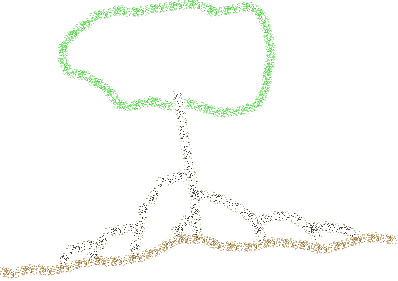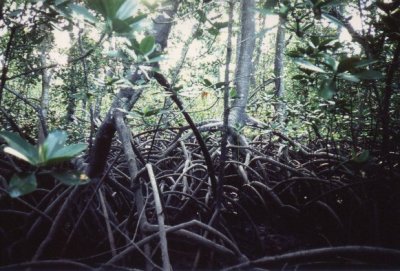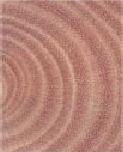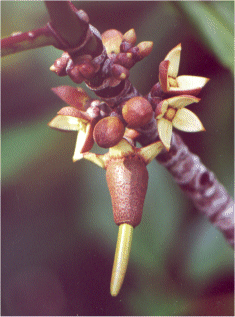
|
A field guide to Kenyan
mangroves
|
|
Rhizophora mucronata Lamk. 1804
Family: Rhizophoraceae

|
Distribution Tree Structure |
 |
 Growth rings in R. mucronata - See Verheyden et al. 2004a
Growth rings in R. mucronata - See Verheyden et al. 2004a
| Leaves Elliptical leaves up to 25 cm in length and 10 cm wide, but more commonly around 12 cm x 6 cm. Presence of a long mucron at the end of the leaves up to 0.8 cm, but usually broken off. Leaves on the forest floor can be identified by the presence of cork warts on the underside of the leaves (see photo on right), however these warts are sometimes only visible in older or dried material. Leaves of this trees are a favorite of many crabs (e.g., Gillikin et al., 2004). |
 |
Root-system
Well developed aerial stilt roots, which allow easy recognition of this species
in the field, since it is the only representative of the genus in Kenya.
Flowers
Flowers occur as axillary inflorescences and open
within the leafy crown hanging downwards from a long peduncle. Flowers have
a yellow-white calyx with 4 thick and hard lobes. When the flower opens the
4 white, and hairy petals appear alternated with the calyx lobes.
Seeds
The seeds of the mangrove Rhizophoraceae are all viviparous. The hypocotyl in
R. mucronata is very long, and narower at the top end.


References:
Tomlinson, P.B., 1986. The Botany of Mangroves. Cambridge University Press. Cambride Tropical Biology Series. 413 pp.
Gillikin, D.P., B. De Wachter and J.F. Tack, 2004. Physiological responses of two ecologically important Kenyan mangrove crabs exposed to altered salinity regimes. Journal of Experimental Marine Biology and Ecology 301(1):93-109. (Reprint).
Verheyden, A., F. De Ridder, N. Schmitz, H. Beeckman and N. Koedam, 2005a. High-resolution time series of vessel density in Kenyan mangrove trees reveal link with climate. New Phytologist 167: 425-435. (Reprint).
Verheyden A., M. Roggeman, S. Bouillon, M. Elskens, H. Beeckman and N. Koedam, 2005b. Comparison between d13C of a-cellulose and bulk wood in the mangrove tree Rhizophora mucronata: implications for dendrochemistry. Chemical Geology. 219: 275-282. (Reprint).
Verheyden, Anouk , James Gitundu Kairo, Hans Beeckman, and Nico Koedam, 2004a. Growth rings, growth ring formation and age determination in the mangrove Rhizophora mucronata. Annals of Botany 94: 59-66 (Reprint).
Verheyden, A., G. Helle, G. H. Schleser, F. Dehairs, H. Beeckman & N. Koedam, 2004b. Annual cyclicity in high-resolution stable carbon and oxygen isotope ratios in the wood of the mangrove tree Rhizophora mucronata. Plant, Cell and Environment 27, 1525–1536.. (Reprint).